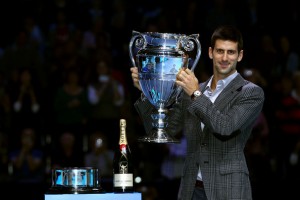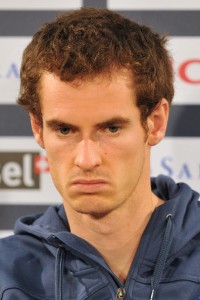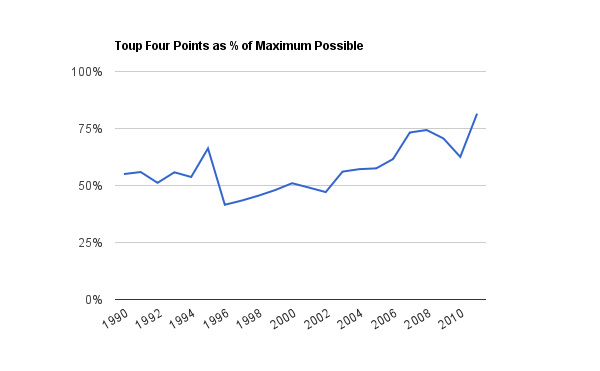There is a theoretical maximum to the number of points that any single tennis player can accrue in a season, and for a long time this year Novak Djokovic was hell-bent on getting closer to it than anyone ever has. If he had his way, that theoretical number would become an actual one next to his name, or he would kill himself trying.  As it was, he did almost kill himself. An on-court collapse the weekend after the US Open foreshadowed a weak end to the season. Consequently, the number buffering his ranking is large (13,630), but it isn’t the largest there has been.
As it was, he did almost kill himself. An on-court collapse the weekend after the US Open foreshadowed a weak end to the season. Consequently, the number buffering his ranking is large (13,630), but it isn’t the largest there has been.
Had it been larger, Djokovic might well have taken the apparently coveted Sportsperson of the Year prize doled out by Sports Illustrated, one of the few sporting publications sufficiently august to boast a swimsuit edition. (As it was, the palme went to a couple of college basketball coaches, which was doubtless nice for them. Those of us who chose to be born elsewhere in the world were united in vague surprise that Djokovic didn’t win anyway, and continued bafflement at the strange interest Americans have in university sports.) He’s probably a shoe-in for the Laureus award, anyway, assuming he can overcome spirited opposition from Sebastian Vettel and the long-serving bowling coach for the Gauteng second XI, who’ve had a good run of late, almost winning several close games.
But I have yet to broach a topic, and already I digress. My point is points, and the consideration that Djokovic didn’t quite take them all. As an interesting corollary, every event Djokovic entered but failed to win was subsequently won by Rafael Nadal, Roger Federer or Andy Murray. Furthermore, of the ten titles Djokovic did win, in only two cases did he defeat someone other than those three in the final (Belgrade and Montreal), the point being that had he somehow lost those matches, the titles would have remained in the club. All of this is a complicated way of saying that the Big Four have once again dominated the season.
They’ve been doing so for years, of course, and the prevailing belief that they wouldn’t do it again seemed to be based on little more than the assumption that doing so defied reason, which is a species of wishful thinking. As it happened, their domination was more profound than ever. Between the four of them,  they claimed every significant title available: four Majors, nine Masters 1000s, the World Tour Finals (and the Davis Cup). On top of that, they all won a 500 level event, and only Nadal failed to win a 250 level one. I am confident in saying nothing like that has happened before.
they claimed every significant title available: four Majors, nine Masters 1000s, the World Tour Finals (and the Davis Cup). On top of that, they all won a 500 level event, and only Nadal failed to win a 250 level one. I am confident in saying nothing like that has happened before.
Furthermore, not only did they win these events, they often filled out the four semifinal berths as well. It has already been pointed out that 2011 was the first year since 1964 that no player reached their first Grand Slam final, and the first time in the Open era that no player reached their first Grand Slam semifinal. That’s quite staggering. There were also no new titlists at the Masters events, and no new finalists. The upshot is that an unholy proportion of available ranking points are commanded by the combined top four (with Djokovic hogging the lion’s share of those).
Since pictures render everything more excitingly comprehensible, here’s a graph to illustrate. It shows the top four’s year end points as a percentage of all available points at the mandatory events (Majors, Masters and the WTF), going back to 1990. The maximum possible points is defined by all four players reaching the semifinals or better at every event.
 The spike in 1995 was due to strong seasons by Sampras, Agassi, Becker and Muster, while the subsequent plummet reflected how calamitously several of those players fell away. Since that low point in 1996, there has been a steady trend towards top-heavy domination. In 2011, the top four accrued 81.52% of the theoretical maximum. If anything it appears as though they underperformed last year, lazily gifting Masters titles to Roddick, Ljubicic and Soderling.
The spike in 1995 was due to strong seasons by Sampras, Agassi, Becker and Muster, while the subsequent plummet reflected how calamitously several of those players fell away. Since that low point in 1996, there has been a steady trend towards top-heavy domination. In 2011, the top four accrued 81.52% of the theoretical maximum. If anything it appears as though they underperformed last year, lazily gifting Masters titles to Roddick, Ljubicic and Soderling.
Is there really any reason to think things will change next year? Federer has cleared 30, but he is emphatically still Federer and the usual rules do not apply. The other three guys are either 24 or 25, allegedly prime ages for a male tennis player. We look at a year like this year, and think surely it can’t continue. But is that just wishful thinking?

One Response to Surely It Cannot Continue